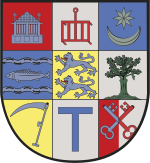Munkbrarupharde
The Munkbrarupharde ( Danish : Munkbrarup Herred ) was a harde in Schleswig .
The Munkbrarupharde arose after the Reformation from the area of the Cistercian monastery Rüde in today's Glücksburg . The symbol of the Harde is the rust of St. Lawrence , the patron of the church in Munkbrarup . The symbol is shown in the coat of arms of the communities Glücksburg Munkbrarup and in the angler coat of arms.
history
The possession of the already secularized male monastery came in 1581 after the re-division of the duchies of Schleswig and Holstein after the death of Duke Johann the Elder from the royal share to the "divided Duke" Johann the Younger . This rounded off the territory by selling distant free float and buying all other properties in the parish of Munkbrarup. He had the old monastery buildings demolished and built Glücksburg Castle on the same site , which now became his main residence next to Sonderburg Castle . The Laurentius Church in Munkbrarup , which has since been damaged by fire , was also renewed at the monastery’s expense.
In 1622 the duke died and his property was divided. Glücksburg now became the residence of the Dukes of Glücksburg (older line) , which lasted until 1779. Their duchy included what was later to become Munkbrarupharde, most of the Sundewitt on the other bank of the Flensburg Fjord and, from 1633 and until 1749, also the central part of the island of Ærø . In addition, there were individual noble goods acquired later, which, however, as so-called allodial goods, did not belong directly to the duchy.
After the death of the last Duke of Glücksburg in 1779, the property reverted to the Danish King in his function as Duke of Schleswig. The Sundewitter part became the Nübelharde of the Sønderborg Office , the Angelner part became the Munkbrarupharde of the Flensburg Office . Although the Munkbrarupharde was significantly smaller than the four old Harden of the office, like its counterpart north of the fjord, it retained a certain administrative special status. The Hardesvogt also took on the tasks that were due to the office administrator (finances) and the house bailiff (public infrastructure) of the Flensburg office in the other Harden. The Munkbrarupharde formed its own judicial district, but the Glücksburg town had a special position in some respects.
In 1864 the Duchy of Schleswig was annexed by Prussia during the war against Denmark . In 1867 it became part of the newly created Prussian province of Schleswig-Holstein . With the introduction of the local court order in June of that year, Munkbrarupharde disappeared from the scene. As a police district, it was combined with the Husbyharde and the Nieharde to form the Hardesvogtei Glücksburg, which existed until the administrative districts were introduced.
literature
- Porskrog Rasmussen, Carsten: De ældre Glücksborgske hertuger, in: Ders., Inge Adriansen & Lennart S. Madsen: De slesvigske hertuger. Aabenraa 2005. pp. 225ff.
- Schlaber, Gerret L .: Administrative tilhørsforhold mellem Ejderen and Kongeåen indtil 2007. Flensborg 2007.

